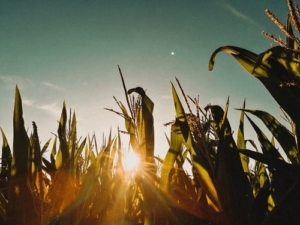
Corn Fun Fact: One acre of corn eliminates 8 tons of carbon dioxide from the air….that’s 1200T from a 150 acre field.
Topics:
– Growing Degree Day Update
– What’s going on in my fields?…..Corn Development, Disease, Crop Water Use….
– Corn/Soybean Insect Update
– Soybean Development – Disease and more…
As of July 21st, we have accumulated approximately the following for Growing Degree Days in 2021:
Planting Date GDU’s2021 Average GDU Departure from average
April 24 1569 1424 +145 (+6 days)
April 30 1515 1387 +128 (+5 days)
May 6 1439 1350 +89 (+3.5 days)
Since the last update on July 9th, we continue to be a few days ahead of the average and the same, to slightly behind, 2020. The cooler temperatures of the past couple of weeks has not cost us to much as far as time is concerned and the cooler temps meant less stress on the crop….which is ALWAYS a good thing.
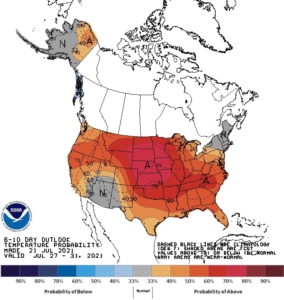
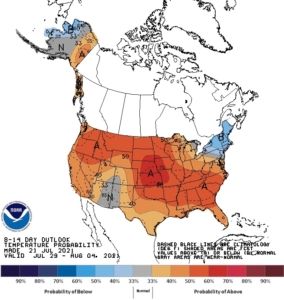
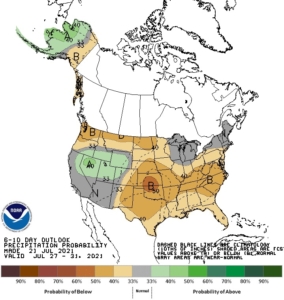
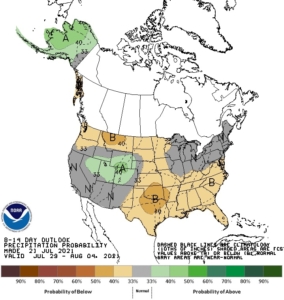
The above maps are the latest 6-10 & 8-14 day forecast maps for temperature and precipitation. You can see that above normal heat and below normal precip is predicted for the next two weeks and forecasts are calling for temps into the 90’s over the next 10-14 days. This will move the crop along and increase crop water usage….more on this below.
WHAT’S GOING ON IN MY FIELD?…..Corn Development, Disease, Crop Water Use..
Most of the corn crop is in the R1 (silking) to Early R2 (Blister Kernel) stage. So far I would estimate that most fields in the area are 50% to Done pollinating. I would expect to see some uneveness in pollination/silking due to the uneven emergence we saw this past spring and from the willowing effect from the storms of July 9th.
- Plant height on the corn crop this year is as high as I can remember for quite a few years….ear height as well. This is across all hybrid families. While not an indicator of yield, extra-tall plant height brings its own management issues. Right now this is mainly connected to irrigation. Irrigation coverage using drop nozzles will potentially not be as even if the nozzles extend to far into the canopy, watch for this over the upcoming heat that is predicted (I have seen years like this where it is wet on one side of the plant and dry on the other, and water never gets to the dry side the rest of the year). Also, the upper canopy of the plant can become stripped up from irrigation equipment, potentially impacting grain fill.
- A captured pollen grain takes about 24 hrs. to grow down the silk to the ovule where fertilization occurs and the ovule becomes a kernel.
- At R1, potassium uptake is essentially complete, and nitrogen and phosphorous uptake are rapid. Last round of N should be going on over the next 7-10 days.
- Blister Kernel occurs approx. 10-14 days after Silking. Starch has begun to accumulate in the watery endosperm and the kernels are beginning a period of rapid, steady, dry matter accumulation that will continue until physiological maturity in approx. 50-60 days after silking.
- At Blister Kernel, maximum ear length is achieved. Although not as severe as at Silking, stress over the next two weeks can still have a profound effect on yield through kernel abortion.
- Kernel abortion from stress can occur through the Milk stage(18-22 days after silking), however when the plant reaches Dough, kernel abortion will no longer take place, and any yield reduction from then on out will be from lower test weight.
- As far as sunlight is concerned, we are currently running about 10% percent below normal over the last 14 days, or from V14-Pollination. Sunlight, of course, is now a much bigger yield factor, since we are now beginning the crucial grain fill period. As such, how much sunlight and when it occurs during the grain-fill period, will play a role in overall yield and late-season plant health. Lack of sunlight early in the grain fill period (i.e. right now) can lead to the ear tipping back as well.
- Extra stress will occur if sunlight is reduced and temps (especially nighttime) are higher than average. This stress occurs because, since temps are high (especially nighttime temps) the energy demand on the plant is higher than average; couple this with reduced photosynthesis, and this leads to greater energy in the plant just going to maintain itself and not to filling the ear. It is an axiom in corn production that when you have to run your air conditioner at night, it is not good corn growing weather.
- Relative Humidity over the past two weeks has been 9% higher than normal, with a daily average of 81% RH during this time frame. This, coupled with average high temps in the upper 70’s to low 80’s (average high temperatures have been 6 degrees below normal during this time period), increases the probability of seeing a greater incidence of leaf disease, especially Gray Leaf Spot and Northern Corn Leaf Blight. We are just starting to see the first Gray Leaf Spot lesions this week. This is about 7-10 days earlier than the last few years. Currently we are seeing very low leaf disease pressure in area fields, however, the past two weeks has allowed good incubation of diseases and we would expect to see an outbreak occur over the next couple of weeks. If we experience warmer temps and lower RH than forecasted, the potential for impact from diseases will be reduced.
- The forecasted temperatures will also increase the potential for Northern Corn Leaf Blight, a disease we normally do not see here but that can blow up in cool temps. https://www.pioneer.com/us/agronomy/northern_corn_leaf_blight_cropfocus.html
- Keep an eye out for Southern Rust as well…..https://www.pioneer.com/us/agronomy/southern_rust_cropfocus.html
- Fungicide application should be going on now and into next week, for best yield response. You want to protect the plant when it is working the hardest, which is silking through milk stage. Fungicide will not help control bacterial leaf streak.
- The past two weeks have seen a daily average of .17-.19 in/day. This is very much a reflection of the lower temperatures and higher relative humidity during this time frame.
- The corn crop is now at its peak water usage, so expect average ET rates to be .25-.35 in/day through the Milk stage. Maintaining an adequate soil moisture profile will be key over the next three weeks or so. As you think about irrigation needs over the next two weeks, keep temperatures and relative humidity in mind as we move forward to see what actually occurs to help reduce potential water stress or potential over watering. If dew points are low (dry mornings), that means relative humidity is low, and ET rates will ramp up quickly and be higher than normal. On the flip side, if heat indices are high in which a 95 degree actual temperature feels like 110 degrees, then relative humidity is high and ET rates will be average to below average. Forecasts for next few days are calling for low dew points meaning potentially higher ET rates than normal.
SOYBEAN UPDATE
- Much of the crop is in the late-R2(full flower) to R3(pod set) stage of growth.
- Peak water use, nutrient demand, and overall energy demand in the plant occurs at R3 and into R4 stage….i.e. right now and into the next few weeks!
- ET rates in soybeans reach peak at R3 stage (.30+ in/day) and will continue to stay high through R6(full seed). See comments above on corn ET rates, as the same applies for soybeans. One will need to be careful not to water constantly to help reduce disease potential (see below on white mold) due to a constantly ‘wet canopy’. If White Mold becomes a problem, it will be best to water at night and leave off during the day so the canopy has some chance to dry out. In heavy soils, when irrigation is needed, we recommend running a heavy irrigation amount (.80 to inch) and then leaving it sit for a while.
- R3 is the prime growth stage for fungicide/insecticide applications….some early planted and early maturity fields are in this stage right now. Same goes for any nutrient application such as N, as well. Now and into next week will be excellent time for application.
- We saw our first infected plants with White Mold earlier this week. This is about two weeks ahead of the last couple of years. Weather conditions of the past two weeks have been very conducive for White Mold to occur. White Mold infestations could be on the severe side this year. Any 2nd treatments for White Mold need to go on at R3 and should be going on now and into next week. See the attached link for White Mold management. http://www.pioneer.com/us/agronomy/managing_white_mold_soybeans.html We recommend Aproach or Delaro fungicide for any white mold control. High temps and dry mornings will slow the disease down.
INSECT UPDATE – Corn & Soybeans
- Keep scouting for Western Bean Cutworm larvae. Moth flight has been somewhat erratic over the past week. From GDU data, we expect that the flight is 75% complete. However, I do think light numbers will continue to fly over the next few weeks, leading to a potential slow buildup of infestation levels. However, any potential treatments should be on, or going on ASAP, as we are now finding small larvae on the ear tips, at top of the silks. Any delay in treating, and they will be too far into the ear tip for control. Overall infestation levels are not super high, but many sandy fields still have the potential to have infestation levels that will cause economic damage.
- Corn Rootworm pressure has been much higher this year than the past few years. Adult rootworm beetle control should already be on, or going on now if planned….Steward insecticide by FMC is an excellent choice for control
- Overall insect pressure in soybeans has been very light. Begin scouting next week for Bean Leaf Beetles as they will begin feeding on developing pods over the next few weeks. So far we are not seeing much for Soybean Aphids. If you have made an insecticide application already, this should give you season long control unless a severe outbreak of one of these insects occurs.
- Dectes Stem Borer – be on the lookout for this insect starting now and into harvest. This is a new insect that borers into the stem and we saw our first case of this insect in August last of 2019. Watch field edges first and let us know if you are seeing wilted and dying plants as they move in from the grassy edges. https://www.pioneer.com/us/agronomy/stem-borer-dectes.html
- Seeing very small colonies of Corn Leaf Aphids(dark green aphid) in area corn fields. They tend to proliferate under cooler and damper conditions, so we may see their numbers increase in the area. They are not an economic concern, but you may begin to notice them as you walk through your fields.
- We are just starting to see our first Spider Mite colonies…..very small and on the very bottom leaves. However, if temperatures turn out as forecasted and relative humidity stays lower than average, infestation levels will increase. Keep an eye out for this insect over the next month or so.
PIVOT BIO

Pivot Bio announces their next generation product! With Pivot Bio’s next generation product for corn, PROVEN 40, farmers can turn to a more dependable nitrogen. Learn more about this revolutionary offering here: https://blog.pivotbio.com/press-releases/series-d We are excited to see what Pivot Bio has to offer and what performance we may see as we move towards harvest….we have many trials out in our area.
Reminder that the Pioneer Annual Customer Appreciation Supper is Friday, August 20th…..it’s our 25th Anniversary, and we ask you, our customer to help us celebrate!! Invite will be coming out soon!
Please contact us with any questions or comments you may have! Thank you for your business!!
Starman Seed Service, Inc.

